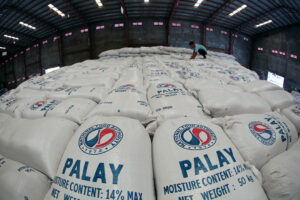By Luisa Maria Jacinta C. Jocson, Reporter
FINANCE Secretary Ralph G. Recto said he is open to reducing tariffs on rice imports in order to help bring down prices of the food staple.
Mr. Recto told reporters on Monday that tariffs on imported rice could be slashed to 17.5% from the current 35%.
“You have to strike a balance between the farmers and consumers. It’s better to divide (the tariff rate) equally,” he said in mixed Filipino and English.
However, the Finance chief said he would leave the issue for the secretary of Agriculture to decide.
In December, the government approved the extension of the reduced most favored nation tariff rates on several commodities, including rice, until end-2024.
Tariff rates for imports of rice were kept at 35% for shipments within the minimum access volume quota and for those exceeding the quota.
Mr. Recto said an executive order adjusting the tariff rate can be issued during Congress’ recess.
“We want it lower. As much as possible, not only up to the end of the year. But possibly, the executive order will be only up to the end of the year… If we need to extend it, then we can extend it. What’s important is to reduce the prices of rice,” he said.
However, Mr. Recto did not agree with the proposal to bring down tariffs on rice imports to zero.
The Finance chief earlier said the retail price of rice could drop by as much as 20% by September due to reduced tariffs and increased production.
Latest data from the Philippine Statistics Authority showed that rice inflation, which contributed almost half to overall inflation, surged by 23.9% in April.
Agriculture department data showed that the average price of local well-milled rice ranged from P48-P55 per kilogram as of May 27, higher than the P39-P46 range a year ago.
Meanwhile, regular milled rice ranged from P45-P53 to P34-P46 per kilogram.
Some analysts welcomed the proposal to lower rice tariffs as this would give consumers some relief.
“I agree with the proposal. Paddy prices will eventually go down perhaps to 2023 levels if tariff cut is big enough. Consumers will also have some relief from high rice prices,” Philippine Institute for Development Studies Senior Research Fellow Roehlano M. Briones said in a Viber message.
Roy S. Kempis, director of the Center for Business Innovation at Angeles University, said that the proposal to reduce the tariffs is the “right thing to do.”
“There needs to have some protection for farmers from cheaper imports or untamed importation that would erode their incentive to produce more and stay in rice farming,” he said in a Viber message.
These tariffs would also generate much-needed revenue and “discipline Filipinos to be responsible consumers.”
Mr. Kempis said the impact of reduced tariffs on farmers will also be positive.
“They will be protected from importation shocks in volume and in price per unit imported. Government is able to support local farmgate prices by way of the extent of the tariffs. Filipino farmers only need decent prices for their palay or rice to continue producing it for the consumers to enjoy,” he said.
On the other hand, Samahang Industriya ng Agrikultura (SINAG) Executive Director Jayson H. Cainglet said that the lower tariff regime in the past years has not brought down rice prices.
“Reduced tariff resulting to more imported rice has not reduced rice prices. Local rice prices are high precisely because global rice prices have been on the rise since last year,” he said in a Viber message.
Mr. Cainglet said that cutting tariff rates will hurt local producers and only favor importers and traders.
Data from the Bureau of the Plant Industry showed that rice imports have reached 1.89 million metric tons (MT) as of May 9.
The US Department of Agriculture projects Philippine rice imports to come in at 3.9 million MT this year.
“If the tariff is brought down further, there is no assurance that rice prices will go down proportionately, because experience shows that the importers, middlemen and retailers just pocket the savings,” Raul Q. Montemayor, national manager of the Federation of Free Farmers, said in a Viber message.
“On the other hand, when the undervalued and cheap imports come in, they are dumped in the wholesale (as against retail) market, and this has a depressing effect on palay prices because local traders who buy palay from farmers sell their milled rice in the wholesale market also,” he added.
Mr. Montemayor said this would discourage farmers from enhancing their own production.
“Allowing cheaper imports does not bring down prices for consumers, penalizes farmers, and benefits only the people in between,” he added.
Mr. Cainglet said the government should not just rely on importation but should boost local production.
“Extreme weather situations and global pandemics are the new normal; that have prodded the rest of the world to be food self-reliant,” he said.
“Most countries have prepared for it by increasing local production and supporting local producers. Here, it is the reverse. Local producers are penalized and importers are rewarded and pampered with four straight years of reduced tariffs on rice, pork, corn and chicken.”
The House of Representatives earlier this month approved on second reading amendments to the Rice Tariffication Law. The amendments seek to allow the National Food Authority to sell rice at subsidized prices during emergencies.
